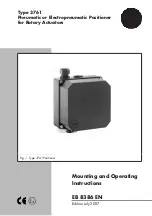
1
Design and principle of opera-
tion
The pneumatic or electropneumatic
positioner ensures the assignment of the
valve position (controlled variable) to the
control signal (reference variable).
The input signal received from a control unit
is compared to the control valve's angle of
rotation and a corresponding pneumatic
signal pressure (output variable) is pro-
duced.
The positioner mainly consists of a pneu-
matic unit including a tension spring (4), di-
aphragm lever (5) and the amplifier (8) with
double plug (7). The electropneumatic
positioner is additionally equipped with an
electropneumatic converter (10).
Any change of the valve position (controlled
variable) is transmitted as a rotary motion of
the actuator over the cam disc (2), the
pick-up lever (1) and the tension spring (4)
to the pneumatic system.
The control signal (positioner's input signal)
from the control unit, if it is a pneumatic sig-
nal, is applied as a pressure signal p
e
directly
to the measuring diaphragm (6). A DC input
signal e.g. from 4 to 20 mA, is directly
passed on to the electropneumatic converter
(i/p converter) where it is converted into a
proportional pressure signal p
e
.
The pressure signal p
e
creates a force on the
measuring diaphragm (6), which is bal-
anced by the force of the tension spring (4).
The movement of the measuring diaphragm
is passed on to the double plug (7) of the
amplifier (8) through the lever (5) so that a
corresponding signal pressure p
st
is pro-
duced.
The positioner's principle of operation is de-
termined by equipping it with either one
(single-acting) or two (double-acting) ampli-
fiers.
The operating direction of the signal pres-
sure with increasing << or decreasing <> in-
put signal can be changed by relocating the
amplifier for single-acting positioners. For
double-acting positioners, the signal pres-
sure connections need to be reversed.
Zero is corrected on an adjustment screw.
The angle of rotation is determined by the
cam disc.
Tight-closing function:
For electropneumatic
positioners with tight-closing function, the
rotary actuator is completely vented or filled
with air (depending on the operating direc-
tion) as soon as the reference variable falls
below or exceeds a given value.
For Type 3761-x21x
, the deactivation func-
tion is initiated when the switching point of
4.08 mA is not reached. The actuator is
completely vented.
For Type 3761-x22x
, the activation function
is initiated when 19.92 mA are exceeded.
The actuator is completely filled with air.
4
EB 8386 EN
Design and principle of operation
Содержание 3761
Страница 23: ...EB 8386 EN 23...
Страница 24: ...24 EB 8386 EN...
Страница 25: ...EB 8386 EN 25...
Страница 26: ...26 EB 8386 EN...
Страница 27: ...EB 8386 EN 27...





















